-
Car Reviews
- All reviews
- Midsize SUVs
- Small cars
- Utes
- Small SUVs
- Large SUVs
- Large cars
- Sports SUVs
- Sports cars
- Vans
Latest reviews
- Car News
-
Car Comparisons
Latest comparisons
- Chasing Deals
The new Kia Sportage has arrived in Australia, but is the fifth-generation good enough to defeat the Toyota RAV4? We find out on testing roads around Sydney.

In fourth-generation form (2015-2020), the Kia Sportage was a competent and appealing midsize SUV, but far from the most well-rounded choice. The fifth-gen Sportage, however – based on Hyundai-Kia’s new N3 platform – looks to build on the nameplate’s reliability, practicality and lengthy warranty while sprinkling in some extra flair.
We split our time between three new Sportage variants at the Australian launch, starting with the entry-level S petrol auto ($35,690). We then jumped into the GT-Line with the new 1.6-litre turbo petrol ($49,990 driveaway) and finally the flagship diesel GT-Line finished in a lovely shade of Jungle Wood green ($54,990 driveaway).
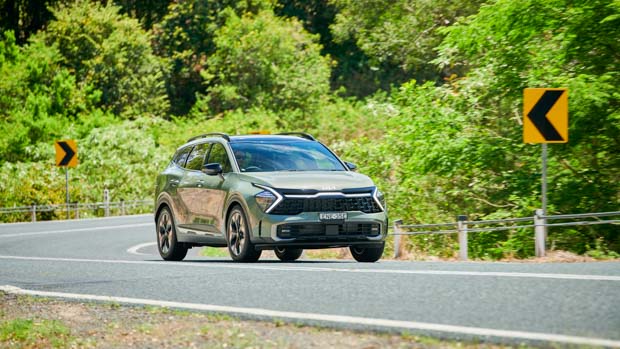
A new platform means the Sportage should drive better, but instantly it’s the design that catches the eye. The Sportage builds on Kia’s ‘opposites united’ design language that debuted on EV6 with the intention of elevating the Sportage’s perceived expense. The LED headlights, ‘boomerang’ front lighting signatures and tail-lights are the highlights of the package, though the distinctive grille – dubbed a mask by Kia – helps too.
There are some subtle differences across the range with S and SX grades sporting body-colour mirrors and roof, where the SX+ and GT-Line score a pseudo black pack from the US-market X-Line. You need to look for the changes though – it’s not immediately evident the base car is the base.
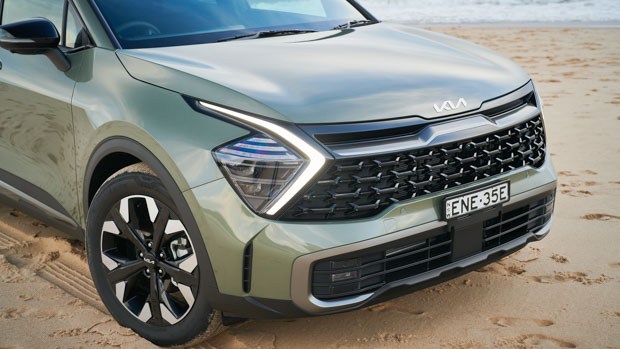
Aussies only get the long-wheelbase Sportage (which is distinguished from the European-spec car by its large C-pillar window), and that means it’s a lot bigger in every dimension. Compared to the previous QL, the NQ5 Sportage is 175mm longer (4660mm), 10mm wider (1865mm) and rides on an 85mm-longer wheelbase (2755mm).
This expanding size puts the Sportage up on the larger end of the midsize SUV segment, measuring far larger than the Volkswagen Tiguan (4509mm) and a little longer than Australia’s favourite midsizer: the Toyota RAV4 (4600mm).
Outside the Sportage certainly catches attention, but the drivetrains are fairly humble. We drove all three engines offered at launch, though Kia suggested a RAV4-rivalling hybrid powertrain could join the line-up later.
The one ‘new’ engine is a 132kW/265Nm 1.6-litre turbo-petrol four-cylinder to replace the old 2.4-litre atmo donk as the mid-price option available in higher SX+ and GT-Line trims. It’s adequately powerful in the Sportage and offers AWD grip, though it doesn’t sparkle with top-end or mid-range grunt.
Another issue is the gearbox behind the turbo petrol. It’s a seven-speed dual-clutch transmission which is fine in the country, but stumbly at urban speeds with inconsistent creep making for lurchy manoeuvring.
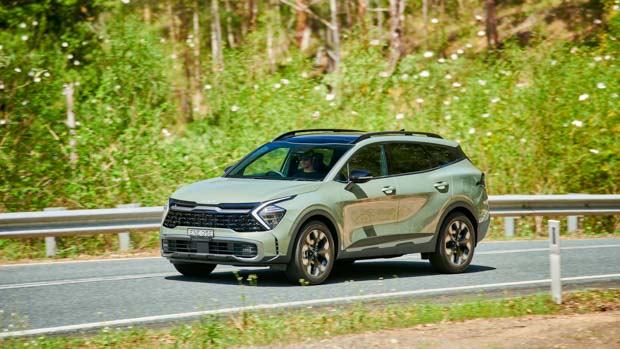
Kia offers another petrol in the Sportage line-up, and you can have it with a six-speed manual, which Kia chose to retain into the latest generation car to provide greater bandwidth for buyers for $1000 less than the auto.
Most buyers will instead opt for the six-speed auto which is tuned well to harness what the 115kW/192Nm 2.0-litre petrol four-pot has to offer the front wheels. When trying to make hurried progress, the engine makes itself heard, yet it has adequate grunt for trundling down country roads and through suburbs.
Finally is the option that was historically the sweetest – a 137kW/416Nm 2.0-litre turbo-diesel four-cylinder. It’s a development of the iron-block R-series diesel, with power up by 1kW and torque 16Nm. With the diesel donk up front, the Sportage has good mid-range grunt without ever astounding, and the eight-speed automatic shuffles the ratios without any hassle.
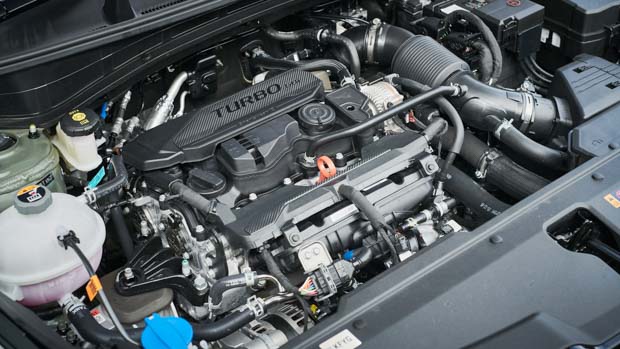
Hooked up to an AWD system, the range-topping $55K GT-Line diesel benefits from a suite of off-road drive modes, and surefooted all-weather grip. At 1900kg, it also has the highest braked towing capacity in the range.
Yet despite the diesel engine suiting Sportage’s loping character best, Kia has predicted it will only account for 20 percent of sales, even though it’s offered across the range, where the turbo petrol is limited to the luxe trims.
The diesel has plenty going for it, but not its weight. Kia’s quotes a 1759kg tare mass for the oil-burning Sportage, which is 116kg heavier than the petrol AWD option.
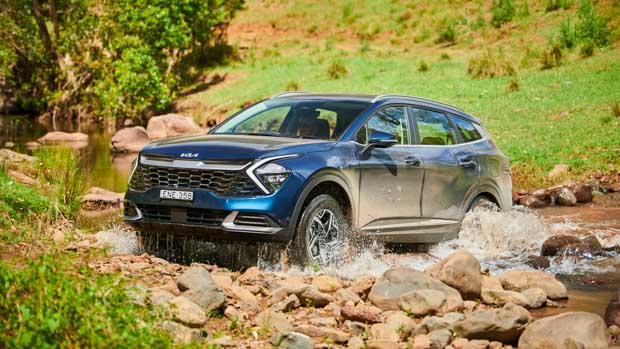
Naturally, this impacts the Sportage driving experience, namely its responses to the driver’s inputs. No Sportage is what you’d call athletic, rather safe and secure with outright grip tempered by 235/55R19 Nexen Roadian tyres. Put the diesel back-to-back with the turbo petrol, and its clear the extra kilos blunt some responses.
Kia Australia prides itself on home-grown ride and handling tuning – despite being a small market globally – and the latest Sportage received the same treatment to great effect. In contrast to the petrol, the diesel sits flatter on freeways and testing backroads, simply steamrolling over imperfections despite big 19-inch alloys.
Above the ride and handling tuning, Kia made a big noise about the Mando dampers with shims that allow damper fluid to flow more freely to keep breakaway force and stiction low without sacrificing control.
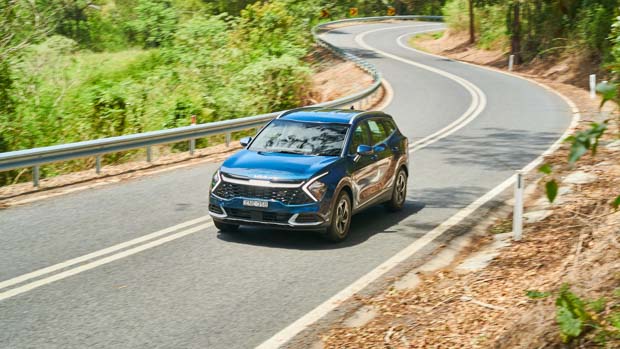
I expected that the base model petrol’s small 17-inch alloys would make Sportage’s already plush ride even better, though this wasn’t the case. There was less harshness from sharp urban bumps, but the suspension feels tuned to work the larger wheels and therefore not matched to the extra spring provided by smaller alloys.
The other gripe is the steering tuning which feels leaden in the hands in Sport mode, with high force needed just off-centre, though with lock on it becomes natural again.
Perhaps the biggest improvement from behind the wheel though is refinement. The old Sportage wasn’t raucous, but the new car suppresses sound well and when adopting a cruising pace on the freeway is simply serene.
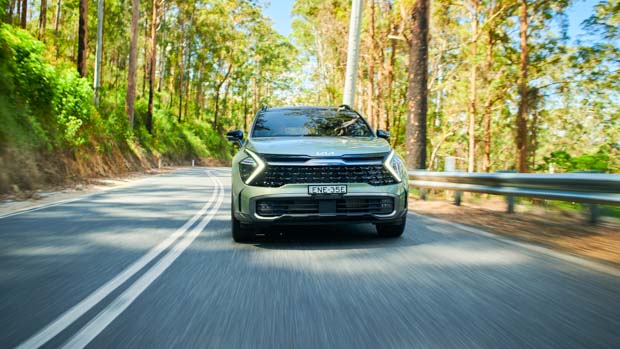
As ever with Kia products, rounding out the package is an impressive safety suite. From the base $35,690 S automatic, the Sportage scores forward and reverse AEB with pedestrian, cyclist and junction functionality. There’s also lane-keep assist, adaptive cruise and reversing camera.
Moving up through the range, the GT-Line wows with a crisp 360-camera and class-leading blind-spot cameras that stream a live feed from the mirrors into the 12.3-inch digital driver’s display.
With a slick driving experience and exterior, the Sportage continues to impress in the cabin. There are digital dials on every Sportage model, with the base S getting an 8.0-inch touchscreen with wireless Apple CarPlay and Android Auto. The SX and up move to a 12.3-inch centre screen, though switches to wired phone mirroring as a result of an ongoing dispute with a smartphone manufacturer.
Every Sportage feels slick, but the GT-Line’s seamless dual 12.3-inch screens that sit in a subtly curved slate really impress. Below that is a novel screen that shortcuts HVAC and media seamlessly. The result is minimal button-clutter, but you never have to go hunting through a touchscreen to adjust fan speed – a very neat touch.
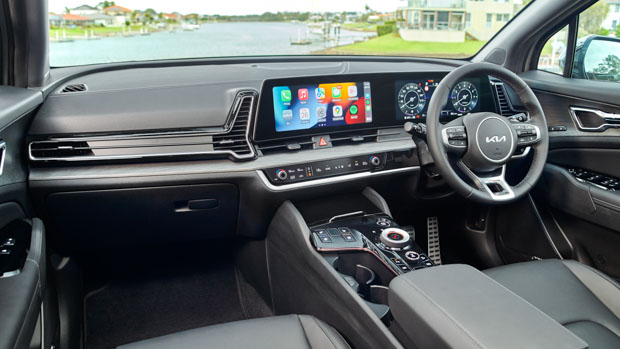
The GT-Line also gets a premium Harman Kardon eight-speaker sound system, though its digital and thin rendition of my favourite music left something to be desired, as did the ‘wood’ trim inserts on the dash and doors. If it was executed properly the Sportage could look fantastic, but the simulated wood is far more Ikea than Parker.
Above the belt line the materials are quality, with plush plastics on dash and door tops. However, it’s an ongoing bugbear that Kia transitions to hard plastic earlier than most other manufacturers, and the Sportage is no different.
Move down to the S and the hard plastics become more oppressive, with no padding for the driver’s door tops and a rock hard armrest that made my elbow ache in just 10 minutes.
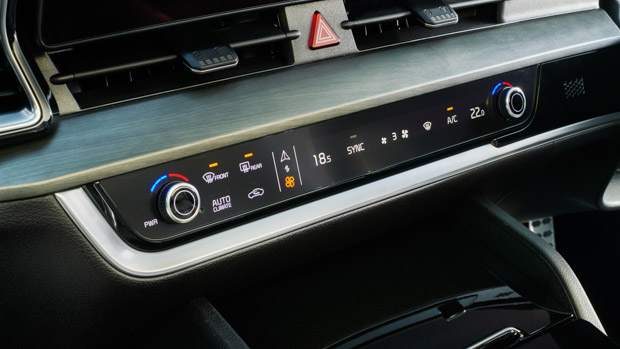
At least the seats are comfy across the range. The lower-grade S gets decent cloth-appointed four-way manually adjustable items, but the GT-Line’s leather and alcantara trimmed pews with heating and cooling are far superior.
Between the seats are a pair of cupholders and a deep centre bin, though across the range there are different gear shifting arrangements which affect practicality – most notably in the manual. The door bins are also compact and couldn’t fit my 700ml water bottle.
Kia’s decision to grow the Sportage means the back seats are palatial, with easily enough legroom behind my six-foot-two self and headroom beneath the GT-Line’s full-length panoramic sunroof.
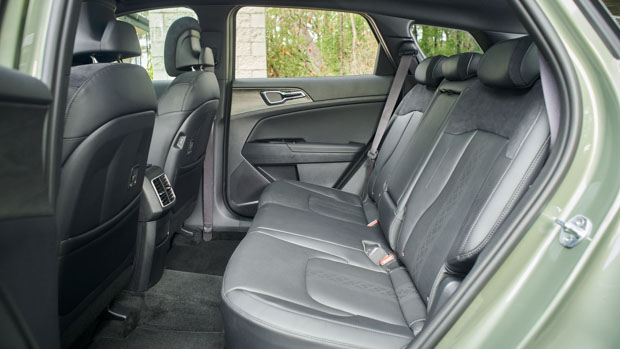
At over $50K driveaway, it would have been nice to have soft-touch materials on the GT-Line’s rear doors. At least an armrest is standard and all grades get rear air vents and USB-C chargers so the back passengers aren’t second-class citizens.
Compared to the closely-related Tucson, Sportage is 20mm longer and most of that is in the rear overhang. That equates to a smidge of extra load space at 543 litres below the luggage cover. There are no nets, but Sportage’s boot is square and easy to pack. Beneath the boot floor is a full-size alloy spare, which is great peace of mind.
Across the range of engines we tested, the efficiencies were respectable. Starting with the thirstiest, the turbo petrol engine returned 8.6L/100km over 80km, and the atmo 2.0-litre scored 7.6L/100km, both close to the ADR combined figures of 7.2L/100km and 8.1L/100km respectively.
The diesel copped the lion’s share of driving and returned a very impressive 5.7L/100km on a highway-biased loop, besting its 6.2L/100km ADR combined claim.
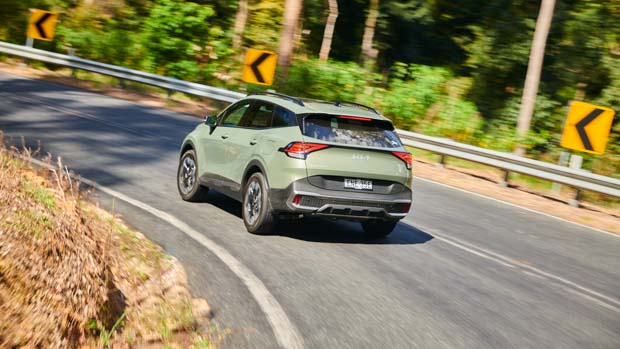
Kia’s seven-year unlimited-kilometre warranty is beginning to face competition from brands like Mitsubishi with its 10-year conditional guarantee, but Kia’s is still very impressive.
Servicing is pricey however, with seven years costing $3479 for the atmo petrol, $3624 for the turbo-diesel and $3988 for the turbo petrol. Detailed year-by-year service pricing was not available at launch.
The latest iteration in the Kia Sportage family presents fantastically from the outside with its crisp LED lighting and engaging design. Sitting on the GT-Line’s 19-inch alloy wheels and finished in Jungle Wood metallic, it’s a head-turning midsize SUV.
And there’s plenty of substance to back it up, certainly in the GT-Line. The base model S has its high points, and is cheap to buy, but its hard plastics lower the tone. The mid-spec SX and SX+ variants won’t arrive for another two months, though when they do the 11-strong range will offer a broad range of choice.
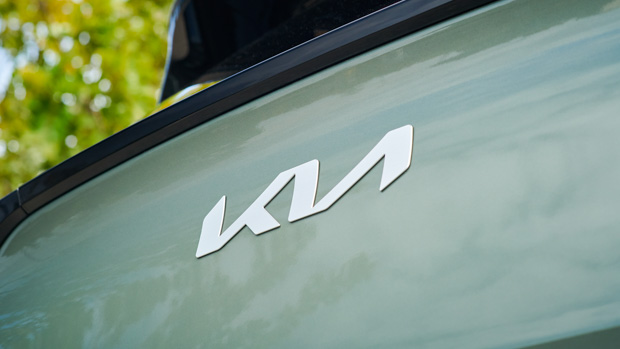
While the drivetrain line-up is decent, each feels a generation behind the best in terms of grunt and refinement, though Sportage’s ride quality is an absolute stand-out point. The Sportage blends comfort and control excellently thanks to its Australian-specific tuning and high-quality dampers.
Outside, inside, and from behind the wheel, the new Sportage is a huge improvement, which should bring it much further up the list of midsize SUVs to consider when making your next purchase.
Variant tested GT-LINE (AWD)
Key specs (as tested)
About Chasing cars
Chasing Cars reviews are 100% independent.
Because we are powered by Budget Direct Insurance, we don’t receive advertising or sales revenue from car manufacturers.
We’re truly independent – giving you Australia’s best car reviews.
The estimate provided does not take into account your personal circumstances but is intended to give a general indication of the cost of insurance, in order to obtain a complete quote, please visit www.budgetdirect.com.au. Estimate includes 15%^ online discount.
^Conditions Apply
Budget Direct Insurance arranged by Auto & General Services Pty Ltd ACN 003 617 909(AGS) AFSL 241 411, for and on behalf of the insurer, Auto & General Insurance Company Limited(ABN 42 111 586 353, AFSL 285 571).Because we don’t know your financial needs, we can’t advise you if this insurance will suit you. You should consider your needs and the Product Disclosure Statement before making a decision to buy insurance. Terms and conditions apply.
Indicative quote based on assumptions including postcode , 40 year old male with no offences, licence suspensions or claims in the last 5 years, a NCD Rating 1 and no younger drivers listed. White car, driven up to 10,000kms a year, unfinanced, with no modifications, factory options and/or non-standard accessories, private use only and garaged at night.
^Online Discounts Terms & Conditions
1. Discounts apply to the premium paid for a new Budget Direct Gold Comprehensive Car Insurance, Third Party Property Only or Third Party Property, Fire & Theft Insurance policy initiated online on or after 29 March 2017. Discounts do not apply to optional Roadside Assistance.
2. Discounts do not apply to any renewal offer of insurance.
3. Discounts only apply to the insurance portion of the premium. Discounts are applied before government charges, taxes, levies and fees, including instalment processing fees (as applicable). The full extent of discounts may therefore be impacted.
4. We reserve the right to change the offer without notice.